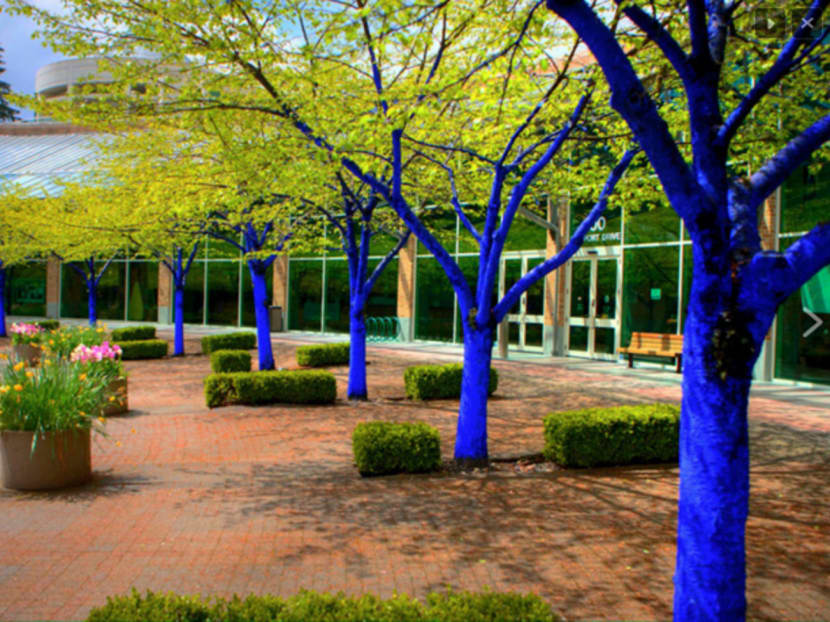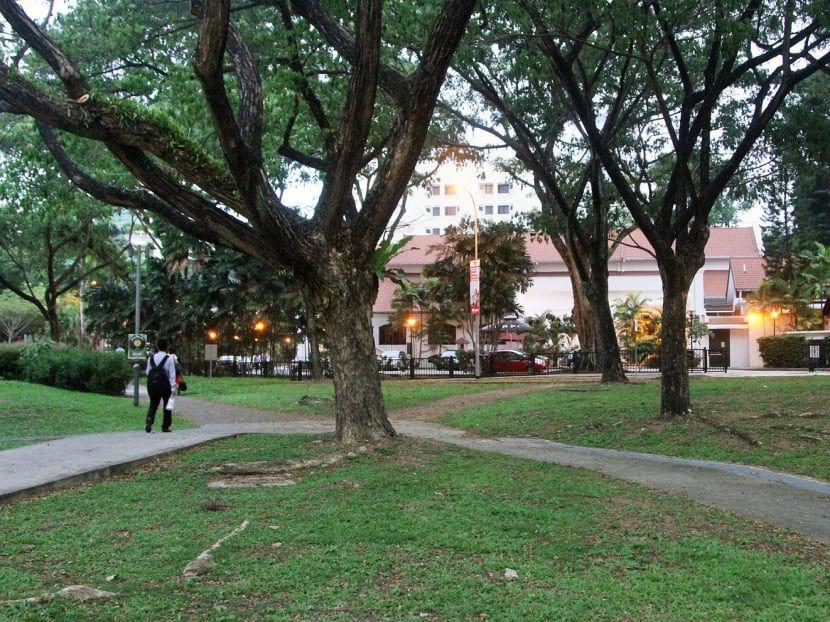NParks does U-turn on art project to colour trees blue after backlash
SINGAPORE — In an about-turn, the National Parks Board (NParks) said yesterday that the bark of the trees at Dhoby Ghaut Green cannot be coloured blue, as it withdrew support for a community art project that had been slammed by some members of the public.


SINGAPORE — In an about-turn, the National Parks Board (NParks) said yesterday that the bark of the trees at Dhoby Ghaut Green cannot be coloured blue, as it withdrew support for a community art project that had been slammed by some members of the public.
The well-travelled installation by Australian artist Konstantin Dimopoulos, called The Blue Trees, aimed to raise awareness of deforestation. It was to have taken place last weekend, with volunteers helping paint the trunks and branches of the trees with a water-based colourant. But the National Arts Council (NAC) postponed it to give the trees time to recover from the recent haze episode, or to find alternative solutions.
NParks initially agreed to support the use of the trees after the NAC’s assurance that the colourant had been used on trees in the United States, Canada and the United Kingdom. Testimonials by overseas tree organisations and arborists said the colourant would not harm the trees.
NParks said it told NAC last Wednesday — a day before NAC announced that the event would be postponed — that it would not be supporting the installation.
“NParks should have been mindful of the sensitivities of the community towards our trees and the potential impact on insect biodiversity,” said Ms Kalthom A Latiff, NParks’ deputy director of arts and heritage parks. “It has therefore reviewed this and has conveyed to NAC that it will not be supporting this project.”
NParks’ permission was needed for the installation as the trees are on park land.
The NAC’s director of arts and community Chua Ai Liang said it respects NParks’ latest position and will discuss it with Mr Dimopoulos.
“We hope we can find a way to collaborate even as the project evolves from its original concept,” said Ms Chua.
Mr Dimopoulos could not be reached for comment by press time.
The art installation had sparked robust debate here, with disapproving comments posted on the event’s ticketing website.
“Trees host whole ecosystems of algae, lichens, fungi, ferns, ants, woodlice, insect larvae, mantis and birds, such as woodpeckers which feed on insects,” wrote Mr Lee Kee Seng. “It’s very bad for nature, very anti-nature.”
Mr Marcus Ng wanted to know how long it would take for the trees to revert to their natural state and the exact composition of the colourant used. Another commenter, planning and urban design strategist Choo Meng Foo, 51, told TODAY he was invited by NParks to a meeting last week with the NAC and Mr Dimopoulos after he made his concerns known. Mr Choo, who considers the colouring of the trees a “violent act against nature”, said it would also encourage participants to disrespect nature and think of nature as being at man’s disposal.
In a list of frequently asked questions put up on the ticketing website, the NAC said the colourant was developed by the artist for the installation and is “biologically and environmentally safe”. The colourant has been used in 14 cities around the world, with tree organisations and certified arborists attesting to its safety for the trees and other living organisms.
The colourant is not paint and consists mostly of water and 100 per cent organic material, “some of which can also be commonly found in children’s face paint”, the NAC said. It can be easily removed with water, the council said. The NAC had also conducted tests with specialists to ensure the health of the trees and other living organisms would not be compromised, said Ms Chua.
The Blue Trees was launched in April 2011 at the Vancouver Biennale and has travelled to countries like the United States, United Kingdom and New Zealand. According to a 2012 report by The Seattle Times, the colourant is made from azurite (a blue copper mineral) and water.
Conservationist Tony O’Dempsey said natural pigments are not necessarily harmless. “How do we know (the colourant) won’t harm the fungi, lichens, and insect life that live on and inside the bark of the tree? Our concern is that the colouration materials suspended in the paint (will) clog pores in the bark as well as the breathing pores on the abdomens of insects and spiders,” said Mr O’Dempsey, chairman of the Nature Society Singapore’s Plant Group, who was speaking in a personal capacity.
But Professor Evan DeLucia of the University of Illinois at Urbana-Champaign’s Department of Plant Biology said water-based paint that is diluted will not choke off all the ability of the bark to exchange gas from the atmosphere to the living tissue within, and would have no effect on the tree. The painting of stems has long been used in the horticultural and forestry industry, for purposes such as the reflection of light (by white paint) and to stop frost damage in winter.
Colouring of the bark will damage the insects and spiders that live on it, but “it’s hard to imagine those would not re-establish very quickly after all the paint is washed away”, said Prof DeLucia, who studied forestry and plant physiology. The colourants, however, should not be painted near the tips of the trees’ buds, he said.
Expressing his personal opinion, Prof DeLucia said: “As a global society, we should do everything we can to support artistic expression. And even when it makes us uncomfortable ... we should be very protective of that right to communicate through artistic expression.”
Mr O’Dempsey questioned the need to change trees to an “unnatural” colour to generate discussion about deforestation, when there is already sufficient beauty in natural flora. Evidence is also needed to show the critters will indeed re-establish themselves, he said.
“There are more than enough professionally edited documentaries and media reports regarding deforestation, not to mention scientific information, which should be more than sufficient to evoke meaningful conversations regarding deforestation,” he said.






